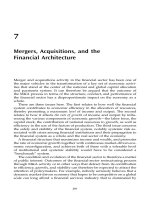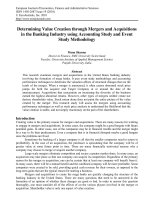ENGLISH FOR SPECIFIC PURPOSES II MERGERS AND ACQUISITIONS
Bạn đang xem bản rút gọn của tài liệu. Xem và tải ngay bản đầy đủ của tài liệu tại đây (72.39 KB, 5 trang )
<span class="text_page_counter">Trang 1</span><div class="page_container" data-page="1">
<b>Name: Nguyễn Duy Hải</b>
<b>Class: A4 – CLC – KTĐN – K48ID: 0951050075</b>
<b>ENGLISH FOR SPECIFIC PURPOSES IIMERGERS AND ACQUISITIONS</b>
<b>---I. INTRODUCTION</b>
In business there is one simple rule: grow or die. Companies on a growth path will take away market share from competitors, create economic profits, and provide returns to shareholders. Those that do not grow tend to stagnate, lose customers and market share, and destroy shareholder value. Mergers and Acquisitions (M&A) play a critical role in both sides of this cycle-enabling strong companies to grow faster than competition and providing entrepreneurs rewards for their efforts, and ensuring weaker companies are more quickly swallowed, or worse, made irrelevant through exclusion and ongoing share erosion.
<b>II. DEFINITION AND DISTINCTION</b>
<b>1. DEFINITION.</b>
The phrase Mergers and Acquisitions (abbreviated M&A) refers to the aspect of corporate strategy, corporate finance and management dealing with the buying, selling and combining of different companies that can aid, finance, or help a growing company in a given industry grow rapidly without having to create another business entity.
<b>2. DISTINCTION BETWEEN MERGERS AND ACQUISITIONS.</b>
Although often used synonymously, the terms merger and acquisition mean slightly different things. When one company takes over another and clearly establishes itself as the new owner, the purchase is called an acquisition. From a legal point of view, the target company ceases to exist, the buyer "swallows" the business and the buyer's stock continues to be traded.
</div><span class="text_page_counter">Trang 2</span><div class="page_container" data-page="2">In the pure sense of the term, a merger happens when two firms agree to go forward as a single new company rather than remain separately owned and operated. This kind of action is more precisely referred to as a "merger of equals". The firms are often of about the same size. Both companies' stocks are surrendered and new company stock is issued in its place. For example, in the 1999 merger of Glaxo Wellcome and SmithKline Beecham, both firms ceased to exist when they merged, and a new company, GlaxoSmithKline, was created.
In practice, however, actual mergers of equals don't happen very often. Usually, one company will buy another and, as part of the deal's terms, simply allow the acquired firm to proclaim that the action is a merger of equals, even if it is technically an acquisition. Being bought out often carries negative connotations, therefore, by describing the deal euphemistically as a merger, deal makers and top managers try to make the takeover more palatable. An example of this would be the takeover of Chrysler by Daimler-Benz in 1999 which was widely referred to as a merger at the time.
<b>II. BENEFITS OF MERGERS AND ACQUISITIONS</b>
Benefits of Mergers and Acquisitions are manifold. Mergers and Acquisitions can generate cost efficiency through economies of scale, can enhance the revenue through gain in market share and can even generate tax gains.
The principal benefits from Mergers and Acquisitions can be listed as increased value generation, increase in cost efficiency and increase in market share.
Benefits of Mergers and Acquisitions are the main reasons for which the companies enter into these deals. Mergers and Acquisitions may generate tax gains, can increase revenue and can reduce the cost of capital. The main benefits of Mergers and Acquisitions are the following:
<b>1. GREATER VALUE GENERATION.</b>
Mergers and Acquisitions often lead to an increased value generation for the company. It is expected that the shareholder value of a firm after mergers or acquisitions would be greater than the sum of the shareholder values of the parent companies. Mergers and Acquisitions generally succeed in generating cost efficiency through the implementation of economies of scale.
</div><span class="text_page_counter">Trang 3</span><div class="page_container" data-page="3">Merger & Acquisition also leads to tax gains and can even lead to a revenue enhancement through market share gain. Companies go for Mergers and Acquisition from the idea that, the joint company will be able to generate more value than the separate firms. When a company buys out another, it expects that the newly generated shareholder value will be higher than the value of the sum of the shares of the two separate companies.
Mergers and Acquisitions can prove to be really beneficial to the companies when they are weathering through the tough times. If the company which is suffering from various problems in the market and is not able to overcome the difficulties, it can go for an acquisition deal. If a company, which has a strong market presence, buys out the weak firm, then a more competitive and cost efficient company can be generated. Here, the target company benefits as it gets out of the difficult situation and after being acquired by the large firm, the joint company accumulates larger market share. This is because of these benefits that the small and less powerful firms agree to be acquired by the large firms.
<b>2. GAINING COST EFFICIENCY.</b>
When two companies come together by merger or acquisition, the joint company benefits in terms of cost efficiency. A merger or acquisition is able to create economies of scale which in turn generates cost efficiency. As the two firms form a new and bigger company, the production is done on a much larger scale and when the output production increases, there are strong chances that the cost of production per unit of output gets reduced.
An increase in cost efficiency is affected through the procedure of Mergers and Acquisitions. This is because Mergers and Acquisitions lead to economies of scale. This in turn promotes cost efficiency. As the parent firms amalgamate to form a bigger new firm the scale of operations of the new firm increases. As output production rises there are chances that the cost per unit of production will come down.
<b>3. OTHER BENEFITS.</b>
Mergers and Acquisitions are also beneficial: When a firm wants to enter a new market
</div><span class="text_page_counter">Trang 4</span><div class="page_container" data-page="4"> When a firm wants to introduce new products through research and development
When a forms wants achieve administrative benefits To increased market share
To lower cost of operation and/or production To gain higher competitiveness
For industry know how and positioning For Financial leveraging
To improve profitability and EPS
An increase in market share is one of the plausible benefits of Mergers and Acquisitions. In case a financially strong company acquires a relatively distressed one, the resultant organization can experience a substantial increase in market share. The new firm is usually more cost-efficient and competitive as compared to its financially weak parent organization.
<b>III. DISADVANTAGES OF MERGERS AND ACQUISITIONS</b>
Despite some advantages of Mergers and Acquisitions, in fact they have much more disadvantages. Statistics show that most Mergers and Acquisitions reduce rather than increase the company’s value. This results from many problems as follows:
Diversification can damage a company’s image, goodwill and shared values such as quality, good service or innovation. For example, in 2008, Facebook, the world’s largest social network, intended to buy Twitter for US$ 500 million; but Twitter refused. Now it was known that was definitely a right decision.
After a hostile takeovers (where the managers of a company do not want it to be taken over), the top executives of the newly acquired company are often replaced or choose to leave. This is a problem if what made the company special was its human capital rather than its products and customer base.
Mergers and Acquisitions can cause diseconomies of scale if business becomes too large, leading to higher unit costs.
Mergers and Acquisitions may lead to the conflicts among different types of cultures, reducing the effectiveness of the integration.
</div><span class="text_page_counter">Trang 5</span><div class="page_container" data-page="5"> Mergers and Acquisitions may need to make some workers redundant, especially at management levels. This may have an effect on motivation.
Mergers and Acquisitions may cause a conflict of objectives between different businesses, meaning it’s more difficult to make decisions and causing disruption in the running of the business. Statistics show that about 66% of Mergers and Acquisitions are not successful because of different Mergers and Acquisitions goals.
Mergers and Acquisitions can be costly due to the high legal expenses, and the cost of acquiring a new company that may not be profitable in the short run. This is why a merger or acquisition may be more of strategic corporate decision than a tactical
One size doesn't fit all. Many companies find that the best way to get ahead is to expand ownership boundaries through Mergers and Acquisitions. For others, separating the public ownership of a subsidiary or business segment offers more advantages. At least in theory, mergers create synergies and economies of scale, expanding operations and cutting costs. Investors can take comfort in the idea that a merger will deliver enhanced market power.
M&A comes in all shapes and sizes, and investors need to consider the complex issues involved in M&A. The most beneficial form of equity structure involves a complete analysis of the costs and benefits associated with the deals.
</div>








